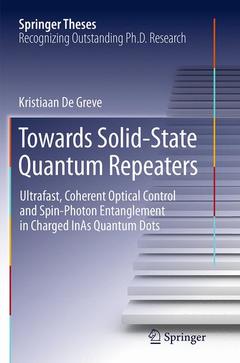Description
Towards Solid-State Quantum Repeaters, Softcover reprint of the original 1st ed. 2013
Ultrafast, Coherent Optical Control and Spin-Photon Entanglement in Charged InAs Quantum Dots
Springer Theses Series
Author: De Greve Kristiaan
Language: English
Approximative price 105.49 €
In Print (Delivery period: 15 days).
Add to cartPublication date: 08-2016
Support: Print on demand
Approximative price 105.49 €
In Print (Delivery period: 15 days).
Add to cartPublication date: 06-2013
148 p. · 15.5x23.5 cm · Hardback
Description
/li>Contents
/li>Biography
/li>Comment
/li>
Towards Solid-State Quantum Repeaters: Ultrafast, Coherent Optical Control and Spin-Photon Entanglement in Charged InAs Quantum Dots summarizes several state-of-the-art coherent spin manipulation experiments in III-V quantum dots. Both high-fidelity optical manipulation, decoherence due to nuclear spins and the spin coherence extraction are discussed, as is the generation of entanglement between a single spin qubit and a photonic qubit. The experimental results are analyzed and discussed in the context of future quantum technologies, such as quantum repeaters.
Single spins in optically active semiconductor host materials have emerged as leading candidates for quantum information processing (QIP). The quantum nature of the spin allows for encoding of stationary, memory quantum bits (qubits), and the relatively weak interaction with the host material preserves the spin coherence. On the other hand, optically active host materials permit direct interfacing with light, which can be used for all-optical qubit manipulation, and for efficiently mapping matter qubits into photonic qubits that are suited for long-distance quantum communication.
Introduction.- Quantum Dot Spin Qubits.- Ultrafast Control of Electron Spins.- Hadamard Gate.- Geometric Phase Gates.- Hole Spin Qubits.- Spin-Photon Entanglement.- Conclusion and Outlook.- A: Fidelity Analysis.- B: Electron Spin-Nuclear Feedback.- C: Heavy-Hole-Light-Hole Mixing.- D: Coherent Hole Rotation Model.- E: Hole Spin Device Design.- F: Visibility of Quantum Erasure.
Current Affiliation:
Kristiaan De Greve
Department of Physics
Harvard University
Cambridge, MA 02138
USA
Previous Affiliation:
Kristiaan De Greve
Department of Electrical Engineering
Stanford University
Stanford, CA 94305
USA
Nominated by Stanford University, USA, as an outstanding Ph.D. thesis
Demonstrates for the first time quantum entanglement between a single InAs quantum dot spin qubit and a single photonic qubit at telecommunication wavelengths
Provides a key element for future quantum networks based on quantum repeaters and quantum teleportation techniques




